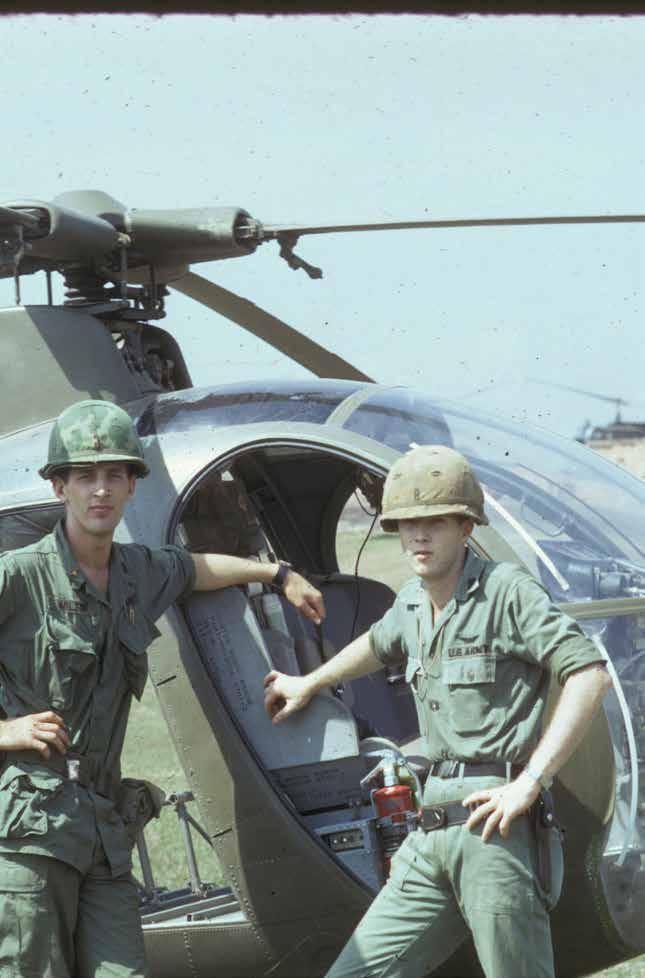
WINTER 2022 1 THE BU G LE WINTER 2022 | VOLUME 29: 4

7 | FROM THE SECRETARY 9 | FROM THE DIRECTOR 10-11 | EVERY VETERAN IS A STORY 12-13 | FROM THE COLLECTION 14-15 | WISCONSIN WOMEN WERE THERE 16-17 | GUEST AUTHOR: RICK BERRY 18-19 | FROM THE ARCHIVES 21 | MEET THE STAFF 23 | BEHIND THE SCENES 24-25 | FROM THE FOUNDATION 26 | CALENDAR 27 | THANK YOU DONORS CONTENTS
Richard F. Berry (right), who was born in Stamford, Connecticut, enlisted in the Army in April 1966. Berry trained at Fort Polk, Louisiana and attended Warrant Officer Rotary Wing Aviation Course in Fort Wolters, Texas, then advanced training at Fort Ruckers, Alabama. In 1967, Berry deployed to Ankei, Vietnam with Company A, 1st Cavalry Division, and served as a Huey pilot from May 1967 through May 1968. Following his service in Vietnam, Berry was deployed to Germany with the 7th Engineer Brigade. While serving in Germany, Berry met his wife, Judith, who worked as a civilian recreation director for a service club on base. Berry returned to Connecticut following his discharge in December 1969, earning a Bachelor’s and Master’s degree from the University of Connecticut. Berry later moved to Madison, Wisconsin and worked worked for the US Army Corps of Engineers, Fish and Wildlife Service, and National Wildlife Refuge System, and the Wetlands Restoration Program in Wisconsin. Berry and his wife reside in Madison.









COMMENTS & SUBMISSIONS We welcome your comments and editorial submissions concerning The Bugle. Comments and submissions should be sent to Jennifer Stevenson at Jennifer.Stevenson@dva.wisconsin.gov THE WISCONSIN VETERANS MUSEUM MUSEUM STAFF DIRECTOR CHRISTOPHER L. KOLAKOWSKI | 608.266.1009 ASSISTANT DIRECTOR JENNIFER VAN HAAFTEN | 608.261.6802 OPERATIONS ASSISTANT ELISE MCFARLANE | 608.261.0534 ORAL HISTORIAN LUKE SPRAGUE | 608.261.0537 CURATOR OF HISTORY KEVIN HAMPTON | 608.261.5409 PROCESSING ARCHIVIST BRITTANY STROBEL | 608.800.6958 COLLECTIONS MANAGER ANDREA HOFFMAN | 608.800.6957 REFERENCE ARCHIVIST RUSS HORTON | 608.267.1790 REGISTRAR SARAH KAPELLUSCH | 608.800.6955 CURATOR OF EXHIBITS GREGORY KRUEGER | 608.261.0541 STORE MANAGER GREG LAWSON | 608.261.0535 MARKETING SPECIALIST JENNIFER STEVENSON | 608.264.6068 EDUCATION SPECIALIST ERIK WRIGHT | 608.264.7663 Join Us Online! 30 WEST MIFFLIN STREET MADISON, WI 53703 ON THE CAPITOL SQUARE 608.267.1799 www.wisvetsmuseum.com MUSEUM HOURS Closed Mondays Tuesday−Saturday 10:00 AM–5:00PM Sunday (April–September) Noon–5:00 PM RESEARCH CENTER HOURS By appointment only 608.267.1790
FOUNDATION BOARD OF DIRECTORS
PRESIDENT
DAN CHECKI
VICE PRESIDENT
JOANE MATHEWS
TREASURER
DAVE HEILIGER
SECRETARY
WILLIAM HUSTAD
DIRECTORS AT LARGE
ALEJANDRO ARANGO-ESCALANTE
DAN GREENE
TIMOTHY LA SAGE
JOSEPH NAYLOR
NATHANIEL T. MILSAP, JR.
JEFF BOUDREAU
PAUL MCEVILLY
COLLECTION DONORS
8/13/22–11/15/22
FOUNDATION STAFF
EXECUTIVE DIRECTOR
JENNIFER CARLSON
608.261.0536
JENNIFER.CARLSON@ WVMFOUNDATION.COM
A most sincere thank you to all who donated to our collection from August 2022–November 2022. Thank you for your generosity and support of the Wisconsin Veterans Museum.
Peggy Angevine
Anita Atkinson
Dan Bartel
Mary Blankenheim
Douglas Bradley
Wendy Carollo
Greg Curl
Kathy Digman
Captain Katherine Divyak and the 115th Fighter Wing
Gordon R. Faust
Michael Fisher
John Gehrke
Harold L. Green
John D. Haas
Sheila Hall
Terry Hall
Barbara Janney
Richard Kane
Christopher Kolakowski
Mary Jane Koscielak
Rick Leyes
Jim Lizon
Dan Lyksett
Dee Mack
MUSEUM MISSION
The mission of the Wisconsin Veterans Museum is to commemorate, acknowledge, and affirm the role of Wisconsin veterans in America’s military past and present
James Megellas
Sally Mergener & Ann B. Geocaris
Rose Mueller
Charles Nolop
Alfred Ordman
Gerald Osborne
John Pasch
Linda Perry
Mike Perry
Yvette Pino
Pam Rockwell
Marlin Schneider
Peter Schuster
Richard Stransky
Carol Strini
Sun Prairie Police Dept.
Marlene Wald
Kenneth Wiesner & the Red Arrow Club of Milwaukee
Mitchell Wise
Joan Wisniewski
The Bugle is published quarterly for our members and friends through the support of the Wisconsin Veterans Museum Foundation. The Wisconsin Veterans Museum Foundation provides funds for the support of artifact acquisitions, exhibit production, and the development of educational programs.
Owen Cyrus Mike, born in Wisconsin Rapids into the Ho-Chunk Nation to Thomas and Pauline (Winneshiek) Mike, attended Cranmore School and Vocational School in Wisconsin Rapids before joining the US Army on October 4, 1961. Mike trained at Fort Leonard Wood, Missouri artillery school and airborne school at Fort Benning, Georgia, and later deployed to Fort Campbell, Kentucky with the 101st Airborne Division. Mike was honorably discharged on October 18, 1963, and joined the Wisconsin Army Reserve. In 1967, Mike enlisted in the United States Marine Corps, and deployed with the 3rd Battalion, 9th Marine Regiment, 3rd Marine Division. Following his service in Vietnam, Mike returned to Wisconsin.
This poem, written by Mike, expresses some of his thoughts and feelings on service in the Marine Corps, those who were fallen or left behind, and his service in Vietnam. Mike closed this poem with “Pinagigi” or Pįįragigi which means “thank you” in Hoocąk. In the later years of his life, Mike was dedicated to speaking his native language and preserving his culture. Owen C. Mike passed away November 18, 2014 and is buried at the Dells Dam Cemetery, Neillsville, Wisconsin.

6
FROM THE SECRETARY

Greetings, and thank you for your support of the Wisconsin Veterans Museum. Our museum is one of our state’s great treasures and is unique in the way that it preserves veterans’ experiences for future generations.
As I travel around the state, meeting with so many veterans and talking with them, it only amplifies the importance of recording their stories into the museum’s oral history collections. Hearing the stories of individuals who served our state and our nation is crucial, ensuring they are not lost to time. It is always wonderful to see the profound impact it makes when we connect citizens and veterans from different generations.
I am elated to see that this issue of The Bugle is dedicated to highlighting veteran stories hailing from the north-central part of the Wisconsin that includes Stevens Point, Wausau, and areas stretching north to Lake Superior. There is a proud tradition of service from individuals from this area of Wisconsin and their stories deserve to be told.
Visitors to the museum continue to be captivated, and it’s no small wonder. The everchanging robust and updated exhibits representing all areas of our state prove that Every Veteran Is a Story.
If you have not been back recently, I encourage you to visit the museum and find new stories of veterans with a personal connection from your region of Wisconsin.
Finally, I wish to acknowledge the dedication and professionalism of our museum’s director Chris Kolakowski, his talented curators, dedicated staff, and the WVM Foundation Board. They commit their efforts unselfishly throughout the year to make our museum the most vibrant and best that it could possibly be.
As we close this year, and look toward the new one, I wish you all a safe, healthy, and happy holiday season.
With shared camaraderie,
Mary M. Kolar Secretary, Wisconsin Department of Veterans Affairs

WINTER 2022 7
Rick Berry stands next to a Sikorsky CH-54 Tarhe "Skycrane." This machine, often dubbed, "flying insect," because of its unusual, insect-like profile. This helicopter, painted with the label, "Big Mother," was extremely versatile in hauling large cargo loads on various missions including infantry transport and recovery, medical supply, and armor transport operations. WVM.2252.I029.T1S11e

FROM THE DIRECTOR
Dear Friends of the Wisconsin Veterans Museum, Greetings and Happy New Year! I hope this finds all of you well and safe. We’ve had a great fall, with many more school groups and visitors retuning as our numbers climb back toward pre-pandemic levels. Cemetery Tours and Veterans Day were highly successful also. We look to forward capitalizing on this momentum in 2023.
Our store is having one of its best years ever. The staff has done a great job expanding our offerings based on visitor feedback. Our store is also one of the only places in Wisconsin where people can buy Space Force and USS Wisconsin SSBN827 apparel. If you haven’t seen what is on offer, please stop by or visit the virtual store at the museum website.
The first months of 2023 feature two very important anniversaries—fifty years of the U.S. direct involvement in Vietnam ending March 29, 1973; and twenty years since the start of Operation Iraqi Freedom on March 20, 2003. Both events affected each generation of veterans and reverberate today. We explore their stories and legacies in these pages.
This issue also continues our approach of focusing on a specific region of Wisconsin, highlighting stories in our collection from that area. This time we’re exploring the north-central region and the area around Wausau and Rhinelander.
Our extensive online offerings continue to attract audiences from across the state, nation, and world. We are continuing them with a mix of in-person events at the museum itself, and you can find information in this issue. These are only possible with the help and support of the Wisconsin Veterans Museum Foundation.
Best wishes to all of you, and thank you for your continuing support. See you at the museum soon.
Best,
Chris Kolakowski

WINTER 2022 9
Maribeth McMahon, a Portage, Wisconsin native, was working as a nurse when she chose to enlist into the Army Reserve in 1951. After serving at stateside hospitals in Michigan and Texas, she deployed to Germany and served with the 5th Hospital in Bad Cannstatt and 11th Field Hospital in Augsburg. Promoted to captain in 1955, she took on additional responsibilities in maintaining the operations of these hospitals that treated wounded and ill American soldiers. In January 1956, while still in Germany, she married a fellow soldier, 1st Lieutenant Otto Stewart. Maribeth returned to the United States after two years serving overseas.


EVERY VETERAN
To:p Maribeth McMahon, third from left—a small penciled-arrow is pointing down at her. Bottom: Maribeth McMahon is seen here wearing a helmet.
Jerome Sudut was born and raised in Wausau, Wisconsin. He dropped out of high school at the age of 16 and lied about his age to enlist in the army in 1946. He trained as a paratrooper and served in the Army of Occupation in Japan before reenlisting in 1949 and training as a military policeman. He deployed to Korea with the 27th Infantry Regiment, 25th Infantry Division and rose to the rank of 2nd lieutenant. On September 12, 1951, Sudut singlehandedly cleared an enemy bunker, receiving serious wounds. He refused medical treatment, gathered his men together, and led another charge in which he was killed. For his leadership and gallantry, Sudut earned a posthumous Medal of Honor.

 By: Russ Horton Reference Archivist
By: Russ Horton Reference Archivist

VETERAN IS A STORY
COLLECTIONS FROM THE
By: Andrea Hoffman Collections Manager
Presently, less than three percent of the WVM collection includes pieces associated with military service from the last two decades. With so much significant history happening since 2000, it is an area the museum continuously works to develop, especially while the historical context for these collections remains fresh in our minds. Add to that an ongoing need for the museum to tell more women’s stories and you can understand our enthusiasm for the increase of such donations that the museum saw in 2022, including the collection of recently retired US Navy Lieutenant Commander Sarah A. Wegmueller.
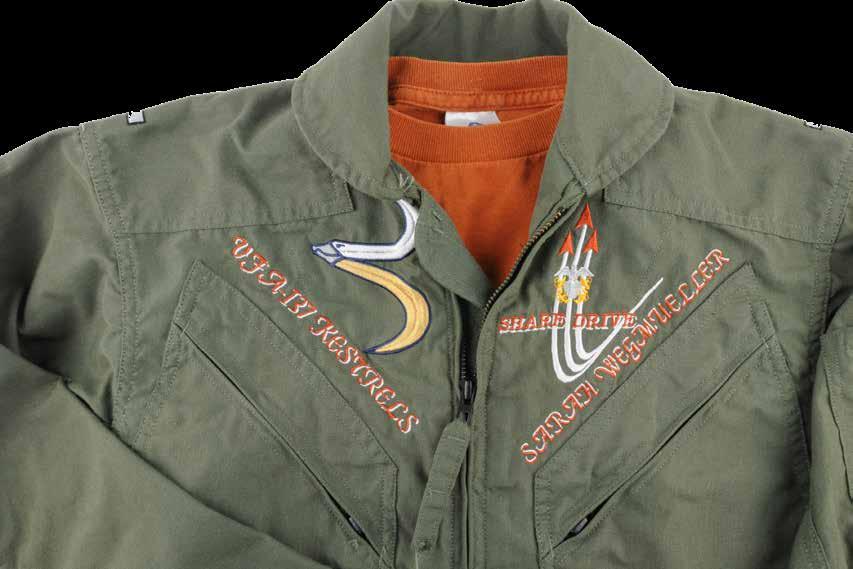
Wegmueller graduated from Athens High School in western Marathon County in 2001 and departed for boot camp that December.

Completing initial training for her rate, intelligence specialist, in July the following year, she left the United States for the first time to head to her first duty station at the Combined Naval Forces Korea (CNFK), detachment Chinhae in southern South Korea. After a year abroad, she returned
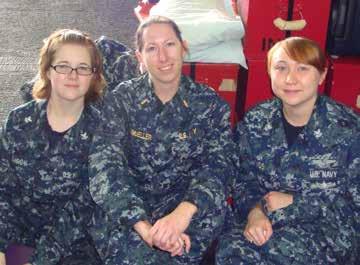
 Ensign Sarah Wegmueller (center) photographed aboard the USS Abraham Lincoln. Photo courtesy of Sarah Wegmueller.
Ensign Sarah Wegmueller (center) photographed aboard the USS Abraham Lincoln. Photo courtesy of Sarah Wegmueller.
stateside to serve at Naval Air Station (NAS) Lemoore with Strike Fighter Squadron 113 (VFA113), deploying upon the USS John C. Stennis during this period. After eighteen months based in central California, Wegmueller was chosen for a commissioning program and attended the University of Wisconsin-Madison starting in June 2005, earning her commission as an ensign in 2008.
Wegmueller then served with the Fifth Fleet, headquartered in Bahrain in the Persian Gulf, from April 2009 to March 2010. Afterward, she returned to NAS Lemoore, serving this time as the intelligence officer for VFA-137
“Kestrels,” an F/A-18E Super Hornet strike fighter squadron. There, then-Lieutenant Junior Grade Wegmueller oversaw the squadron’s computer systems as a collateral duty, earning her the call sign “Share Drive” from her fellow officers. At the time, it was notoriously difficult to seamlessly transfer thousands of files from the navy’s shore-based computer network share drive to the network aboard the ship— a challenge that frustrated Wegmueller but amused her colleagues.
Wegmueller deployed twice in support of Operation Enduring Freedom aboard the USS Abraham Lincoln during this 26-month period with VFA-137.
In May 2012, Wegmueller was then sent to England to serve with the European Command Joint Analysis Center in Molesworth, where she remained for nearly two and a half years, earning the rank of lieutenant before leaving active duty to join the US Navy Reserve. She then served with both the Navy Operations Support Command (NOSC) here in Madison as the Officer in Charge of the Operational
Support Unit, and the Naval Aviation Warfighting Development Center (NAWDC) Unit 0194 as an instructor from February 2016 until October 2021. During that time, she deployed to Al Udeid Air Base in Qatar with the Military Information Support Task ForceCentral (MISTF-C) from October 2017 to July 2018. Following 20 years of service, Lieutenant Commander Wegmueller retired from the navy on October 1, 2021. She remains an area resident as she pursues a PhD in Forest Ecology from UW-Madison. We are grateful to add her truly unique and comprehensive collection to the museum’s holdings.
Left: CWU-27P Nomex flight suit worn by Wegmueller while serving with Strike Fighter Squadron 137 (VFA-137) 20102012. This atypical, embroidered flight suit was worn only domestically and during special squadron pride events. It is shown with the dark orange T-shirt specific to her squadron. V2022.060.4
Information Dominance Warfare Officer insignia worn with the Navy Working Uniform (NWU) Type III, c. 2015. V2022.060.45
Typical hook and loop (Velcro) style name tag normally worn with flight suits. V2022.060.45

Below: Service ribbons earned by Wegmueller at the time she was a lieutenant include the Navy Achievement Medal with two gold stars, Navy Good Conduct Medal with bronze star, Navy “E” Ribbon and the National Defense Service Medal, in addition to service medals related to the Global War on Terrorism. V2022.060.47 & V2022.060.48
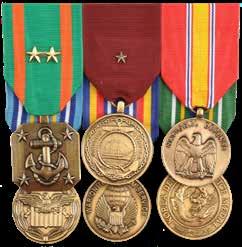

13
WISCONS IN WOMEN WERE THERE OPERATION IRAQI FREEDOM PROVING THEIR
On March 20, 2003, Operation Iraqi Freedom (OIF) officially began. More than 3,900 active Wisconsin troops deployed to Iraq. Among the first Wisconsin units to arrive was the Wisconsin Army National Guard’s 32nd Military Police Company. In preparation for major combat actions, medical personnel also deployed to the theatre in February 2003.
"But it’s like I constantly felt like I had to prove myself, because then otherwise people just wouldn’t take me seriously.”
—Lt. Brooke Boushon
on September 2, 2001, just before the 9/11 attacks, and just a year after graduating from the University of Wisconsin-Madison with a nursing degree. During her deployment she mainly worked in the ICU and the emergency room. As a nurse Lt. Boushon dealt with a wide variety of ailments from third degree burns to heart attacks to tooth removals.
Wisconsin women were there contributing various skills to the mission. Although those skillsets differed, the need to prove themselves to their colleagues is a uniting theme in their service and one common for all women who serve. Included in these troops were Wisconsin natives, Lt. Brooke Boushon of Madison and Sgt. Laura Naylor, now Colbert, of Waupaca.
Brooke Boushon served as an intensive care unit (ICU) nurse with the Air Force in Iraq and Jordan. She entered active-duty
In her oral history, Lt. Boushon talked about her experience with Special Forces patients, where discretion was vital to the point where the patients were addressed by numbers, not names. Her memory was tested as they were not allowed to document anything about the patients, and so they had to memorize the health information for each patient along with any medications they were given. Lt. Boushon discussed riding on helicopters with patients to Baghdad and other places to get CT scans.
14
THERE SKILL
By: Mamaa Yorke Marketing Assistant
Despite having critical medical skills vital to the mission’s success, Lt. Boushon had to deal with sexism during her deployment, “People acted like I didn’t know anything, like I was a dumb blonde that I--the only reason that I was working in the ICU was because they had no other place to put me. It’s like, I would say something, and people would just totally discount it because I’m the one that said it. And I would get so mad. So then I’d have to pull out a textbook, or look it up on the internet, or show them, “Hey, no. This is actually what the research says.” And then they’d be like, oh okay, well maybe she knows what she talking about. But it’s like I constantly felt like I had to prove myself, because then otherwise people just wouldn’t take me seriously.”
Laura Naylor of Waupaca served in the National Guard’s 32 nd Military Company and had joined the army just months before the September 11 th attacks. In deployment she spent 16 months in Iraq,

operating as a Humvee driver, an Iraqi police officer trainer, and in rebuilding the police stations that were attacked. Laura Colbert had the special experience of having a high ratio of women to men in her company, but that didn’t stop her from experiencing culture shocks while in service.
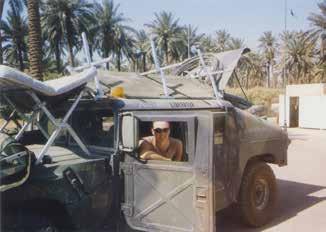

“[I]f you’re an infantry person, you don’t work—or infantryman, you don’t work with women, they have no idea what we’re capable of doing. Just like my brother said, “I never thought I’d be here with all these women and all these guns.” And so, it— there was a lot of stereotypes to break while we were over there, and I think we did a very good job of breaking them.”
These women without a doubt were invaluable to their team as people with skill, courage, and dedication. They serve as a reminder that our competency is not defined by what others believe of us, but rather, what we know our capabilities to be.
WINTER 2022 15
Select images from the Laura Naylor Collection of her deployment to Iraq.
RICK BERRY'S SCRAPBOOK
By: Rick Berry Guest Author
My mom included this cartoon in a scrapbook she compiled regarding my military service. Portions of the scrapbook are exhibited on a touch screen display in the Souvenirs of Service exhibit at the Wisconsin Veterans Museum. Note the expression on the face of the left seat Huey pilot and the caption. The caption is quite accurate. (“Huey” is the nickname given to the Bell UH-1 Iroquois helicopter) .

I served as a warrant officer Huey pilot in Vietnam flying for A Company, 229th Assault Helicopter Battalion, 1 st Cavalry Division from May 1967 to May 1968. Army helicopter pilots in Vietnam were mostly warrant officers and relatively young as most took advantage of an army program which allowed men to enlist for the army’s Warrant Officer Rotary Wing Aviator Course. One could do that immediately after completing high school. We had, for example, at least one 19 year-old pilot in our assault helicopter company. It took about a year to complete basic training and flight school and receive your wings and warrant officer bars. Most new army helicopter pilots received orders for an aviation unit in Vietnam as their first duty station after flight school.

Flight school training was excellent. The final portion of the training was at Fort Rucker, Alabama where we transitioned into the Huey and received tactical training in formation flying, low level navigation, night flying, formation, and single ship approaches to and landings in simulated landing zones, etc. The instructor pilots were all Vietnam veterans; they knew firsthand exactly what flying a helicopter in Vietnam entailed and did their very best to prepare us for our upcoming assignments. Flight school training did not, however, include high overhead approaches;

16
one learned the approach on the job after arriving in Vietnam.

A high overhead approach was used on single ship missions, only in daytime with decent visibility and usually when hauling supplies (ammo, food, water, equipment, etc,) to units in the field. For some reason, perhaps having received enemy fire on an earlier flight to the landing zone or being informed by the infantry that the enemy was present near the landing zone, the aircraft commander would decide to execute a high overhead approach. Its purpose was to get from an altitude less vulnerable to enemy small arms fire, perhaps 3000 feet or so above the ground, to on the ground in the landing zone as quickly as possible while remaining in the relatively secure airspace directly over the landing zone.
The pilot would completely unload engine power to the rotor system when directly over the landing zone, enter a tight, perhaps 60 degree, turn to his side of the Huey and use the pedals to kick the aircraft out of trim. All three actions would cause the aircraft to rapidly descend. You would make one and one-half or two 360 degree turns on the way down and time everything so that coming out of the last turn the aircraft would be facing into the wind and be on short final approach to the landing zone. You would then get the nose up, restore power
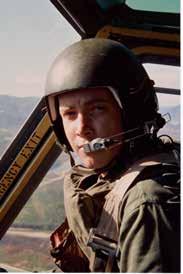
to the rotor system, get the aircraft back in trim, and land. One could go from 3000 feet to on the ground in a minute or so. This was actually the safest way to approach a landing zone where enemy ground fire was anticipated. It was also really fun to fly.
Aircraft commanders functioned as combat instructor pilots for the new guys joining our company from flight school. The aircraft commander designation was not based on rank (most aircraft commanders were Warrant Officers - WO1), but rather on the demonstrated ability to fly the aircraft and experience with the various mission types we flew. One would fly as copilot or, as we termed it, Peter Pilot, for perhaps 300 to 400 hours of combat flight time before being designated as an aircraft commander.
Back to the cartoon, on a resupply mission one day I demonstrated the high overhead approach technique to a new pilot joining our company by the name of Roderick. The experience must have made an impression on Roderick as the cartoon showed up on the message board in the A Company operations bunker.
View this cartoon and peruse Rick’s digital scrapbook, which includes fantastic views of the Hueys in Vietnam, in the Souvenirs of Service exhibit on view now.

WINTER 2022 17
The Hand-Me-Downs of Betty May Whitney
 By: Brittany Strobel Processing Archivist
By: Brittany Strobel Processing Archivist
Betty May Whitney Prieve, a Merrill, Wisconsin resident, served as an aviation machinist’s mate, third class in the US Navy Women Accepted for Volunteer Emergency Service (WAVES) during and after World War II. Prieve joined the navy to follow her brother, Clarence “Ed” Whitney who served as an aviation ordnanceman, third class in the navy. During her service, Betty trained at Hunter College, for basic training and Norman, Oklahoma for mechanical training. Both Whitneys were stationed at Norman for training. Following her training, Betty Whitney was stationed at Lakehurst, New Jersey serving as a flight crew mechanic on airships that patrolled the east coast for German submarines. While in service in New Jersey, Whitney had applied for overseas service and received her overseas order at the same time she was notified that her brother had been killed in action. Before leaving, Whitney was able to go home to Merrill and attend a memorial service for her brother.
Stationed in Hawaii, Whitney continued to work as an aviation machinist mate on airplanes. Whitney served in the navy until 1946. Following her service, Whitney was active in veterans groups, including the American Legion and the WAVES International Women of the Navy, the Navy Club, Allied Vets, and the veterans board for the Milwaukee War Memorial. Betty Mae Whitney Prieve passed away January 9, 2017 and is buried in the Central Wisconsin Veterans Memorial Cemetery.
While in training, Whitney received this pair of coveralls, handed down from WAVES class to WAVES class until the last WAVES attended aviation machinist mate school. Tradition stated that the coveralls were handed down to a member of the next class and they would be worn on the last Thursday before graduation before being left to the next class. The women who received the coveralls marked them “R.C.” with their name underneath, until they were finally returned to the original owner, Seaman Mary Radcliffe. Whitney was the last recipient of the coveralls before they were returned. (WVM.2140.I036.02)
18
Top right: Photograph of four of the Whitney siblings: Betty Mae on the far left, Clarence “Ed” on the far right. The sisters had borrowed their brother’s clothes for the photograph while he was home on leave in Merrill. (WVM.2140.I012.06)
Bottom right: Whitney in uniform. (WVM.2140.I059.03)
ARCHIVES FROM THE



WINTER 2022 19
Lorraine Conley was born in January of 1920, six months before women were granted the right to vote, in Tomahawk, Wis. Now, after celebrating her 100th birthday, she reflects on her centurylong life and the history she has been a part of.
women were responsible for over eighty percent of the positions previously held by men.
Her father George Conley served in the U.S. Army as a machine gunner during WWI and married her mother Ruth Riebly in 1919.

Lorraine was twenty-three years old when she went to Camp LeJeune for boot camp. Following basic training, she submitted her name for the rigorous training to become an air traffic controller. She was accepted and spent six weeks training before returning to Cherry Point, N.C., where she would eventually become a staff sergeant.
Lorraine M. "Connie" Conley Allord and Lawrence B. Allord were married in 1941 and decided to enter the military together in 1943 for service during WWII. A Tomahawk, Wisconsin native, Lorraine "Connie" Allord served as an air traffic controller in the US Marine Corps Women's Reserve while Lawrence Allord served as a Navy Seabee. Following service, they lived in Wisconsin. Connie passed away Novemeber 15, 2022 at 102 years old. The Wisconsin Veterans Museum preserves the story of her service through an oral history recorded in 1995. Below is an excerpt from the interview.
Allord: Cherry Point is the world’s largest Marine Corps air station. It was a final training base before the pilots went overseas. We had just about everything that the navy and Marine Corps flew. We had fighter planes, F4U's, SBD's. We had B25s, which we called PBJ's. We had R4D's, which is a C47. We had larger bombers, not many, B24’s but they were rather scarce but we concentrated mostly on fighter planes and bombers.
As an only child growing up on a farm, Lorraine spent much of her early years as her father’s hunting and fishing buddy. She knew hunting and fishing weren’t typically “girls’ activities,” especially at the time, but her family never limited her, setting the expectation that she could do whatever she put her mind to. That mindset is likely what led her to military service.
Following their service, the Allords moved back to Madison, where they raised their three children and she sought to resume her work as an air traffic controller. Unlike what she experienced in the military, not everyone was ready to work side by side with a woman. To this day she still expresses disappointment that she could not continue to work in a field she had grown to love. Later Allord earned her commercial pilot license, but decided that as a mother, she “could not see herself buzzing around the air much,” and taking the risks that flying brought.
Interviewer: Where did these planes go, did they fly over the ocean to train?
Allord: We had gunnery ranges, of course, we were right near the coast and they had gunnery ranges right on the coast and we took care of their schedules and it was up to us to see that the ranges got their schedules every morning, of which squadrons would be out for practice and we processed all of the squadron’s flying schedules. We were all licensed control tower operators but we didn’t necessarily work in the tower. We worked in clearance.
Interviewer: Did you sometimes work in the tower?
In her living room Allord proudly displays the Joan of Arc, a favorite of the pieces she has painted. Joan of Arc is famously remembered as a female heroine who led the French army’s victory over the English at Orléans and was burned at the stake as a nonconformist of her day.

Allord: Yes. We rotated. Eventually, as I was promoted, I became NCO in charge of one of the shifts. We worked rotating shifts every day we rotated until Friday and we worked the same shift for the weekend and we worked seven days a week and once a month got 71 hours free.
Interviewer: It sounds like a very busy place.
Allord: It was! It was a very stressful job because human errors could cause crashes.
Interviewer: What was the most stressful part of the job?
In 1941, Lorraine married Lawrence Allord and following the attack on Pearl Harbor, they were both motivated to join the military. Lorraine’s husband joined the U.S. Navy, while she joined the U.S. Marine Corps Women’s Reserve as one of the thousands of women who stepped into roles to support the war effort. During the war, she recalls,
Allord often reflects on her time in the military as an air traffic controller. She was one of the first women in the air traffic control room and supervised a group of men who respected her and followed her lead. Every plane in and out of Cherry Point had to be cleared through her department. She recalls it being a tremendous responsibility and very stressful at times. After the long days at work, Lorraine would often write to her husband, stationed in the South Pacific. After a year and a half apart, they requested leave together and met in Chicago for her twenty-fifth birthday, a day Lorraine describes as “one of her best.”
Allord says “she was just a farm girl who grew up to be a Marine,” but others may call her a trailblazer or hero, much like Joan of Arc, for her accomplishments.
Allord: Just keeping up with the traffic because we averaged like—we not only had our own people to take[care]of, we had nine outlying fields and we took care of their traffic too. So in Clearance we had different positions. For instance, one took care of the whole east coast traffic through ATC Center in Washington for cross-country flights. Another position took care of local flights out of Cherry Point. Another position took care of the outlying fields. Another one took care of the counter where pilots came in to file flight plans and all of those had to be transmitted to the tower so they knew what was coming up and when that plane appeared either landing or to take off, they in turn, would call to that position into Clearance. If any plane was a half-hour overdue, we were on alert to watch for it, to inquire, to make calls to see if it had shown up someplace else and alert the OD and if it was an hour overdue, we sent out search planes from Air/Sea Rescue.
20
Allord stands in front of her painting of Joan of Arc. In a WDVA article from 2020, Allord shared her love for Joan of Arc and says about herself, “She was just a farm girl who grew up to be a Marine, but others may call her a trailblazer or hero, much like Joan of Arc, for her accomplishments."
TOUCHING VIRTUALLY EVERYTHING THAT HAPPENS IN THE MUSEUM: THIS IS JENNIFER VAN HAAFTEN
By: Jennifer Stevenson Sr. Marketing Specialist
Fromthe corn fields of her home state of Iowa to the field of museum work, Jennifer Van Haaften has dedicated the past 30 years to creating a positive visitor experience through museum education and programming. As the Assistant Director of the Wisconsin Veterans Museum, she has a hand in everything from supervising the collections section, store and budget, managing facilities and security, to serving on communications and interpretation committees.
Although she is not a veteran herself, the call to military service was answered by several of her family members. Her maternal uncle, Andrew H. Higgins (who says he took President Kennedy’s words to heart, Ask not what your country can do for you, but what you can do for your country) worked as an aircraft electrician on the USS Enterprise in the Gulf of Tonkin during Vietnam.
Van Haaften’s maternal grandfather Lt. Laurence B. Higgins, served with the 168th Infantry, 34th Division during World War II. This February marks eighty years since Lt. Higgins was wounded and captured in action in North Africa. He was transferred to a hospital in Italy to recover and then transferred to Oflag 64, a POW camp for Allied officers. He was a POW from 1943 until he was sent on a prisoner exchange in February 1945, traveling from Sweden to the U.S.
Van Haaften shared that although her grandfather didn’t talk about his war experiences with the grandkids, she learned his story from her parents, his letters home, and reading about the history of the places he was in during that time. This curiosity about a story so close to her may have influenced her to spend the past seven plus years at the Wisconsin Veterans Museum.
Van Haaften says, “I am a historian first, and I have always loved the complexity of history, which reflects the complexity of humanity across the ages. Discovering more stories and giving them voice to a wider audience is why I work in museums.”
As her mission continues, Van Haaften is passionate about creating a rich visitor experience for museum guests. Explaining that collections and visitor experience are tightly entwined, she says, “In order to make a richer visitor experience that touches upon all types of military service members from all backgrounds, our collections also need to reflect all the types of military service members from all backgrounds. I’ve discovered that me working in all these areas helps to facilitate our best ways for finding and sharing stories that resonate with a wider audience.”

WINTER 2022 21
MUSEUM STAFF MEET THE
Nearly 160 years ago, the Emancipation Proclamation ended slavery in the Civil War South. Have you ever considered how that event affected Wisconsinites? The Wisconsin Veterans Museum staff and volunteers shared some of those stories at the Talking Spirits Cemetery Tours, Henceforth and Forever Free this past fall .


Tours were held October 3-9 at Forest Hill Cemetery in Madison. During the week, nearly 600 school children from across the state heard live actors share the stories of four Madisonians affected by the Emancipation Proclamation. On the weekend, staff and volunteers led candle lit tours through the cemetery Saturday night. Sunday afternoon tours were filled with people who preferred daylight. Wisconsin Veterans Museum staff welcomed 1200 people to Talking Spirits Cemetery Tours on that weekend.
Videos of the live-actors portraying Notley Henderson, John Wayles Jefferson, Anna Mae Miller, and Captain Frank Newton are on the museum’s YouTube channel.

This project is supported by Dane County Arts with additional funds from the Endres Mfg. Company Foundation, The Evjue Foundation, Inc., charitable arm of The Capital Times, the W. Jerome Frautschi Foundation, and the Pleasant T. Rowland Foundation. This project is also funded in part by a grant from the Wisconsin Humanities Council, with funds from the National Endowment for Humanities and the State of Wisconsin. Any views, findings, conclusions, or recommendations expressed in this project do not necessarily represent those of the National Endowment for the Humanities. The Wisconsin Humanities Council supports and creates programs that use history, culture, and discussion to strengthen community life for everyone in Wissconsin.
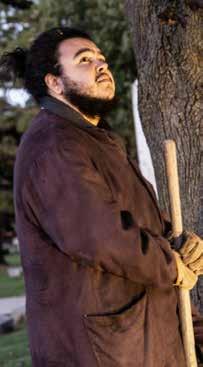
22
By: Jennifer Stevenson Sr. Marketing Specialist

BEHIND THE SCENES CURATOR
OF EXHIBITS
Behind every display in the museum galleries, and those that go out across the state, stands museums staff who do the physical work to bring their stories together. At the Wisconsin Veterans Museum that task lies mostly on Curator of Exhibits Greg Krueger.
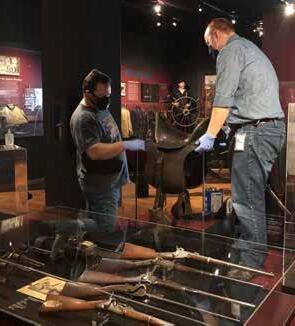
As he sums up the function of the department, “My job is to make sure the displays look good—so when planning an exhibit, I draw upon past experiences and incorporate mounting techniques, designs, lighting techniques, etc. that have worked well in the past and either incorporate them outright or modify them to suit the current need.”
While the curator of exhibits is often the jack-of-all-trades problem-solver when there is a leak in the gallery or a light bulb pops at the 30ft tall ceiling above the Battle of The Bugle diorama, this position also involves a breadth of tasks beyond maintenance of the exhibits. Krueger says, “I assume a lot of different roles within the museum. One day I am researching new subject matter, the next I am driving to our veterans home in King to document their historic cottage district. While my title suggests exhibit work, I am just as likely to spend the day working with potential donors to bring-in their family’s service-related artifacts or visit a different museum to offer suggestions on how they can improve their lighting.”
Despite the varied tasks he is charged with, Krueger focuses on a responsibility to bridge the civilian-military divide with his work. He says, “When a veteran enters our doors, they largely recognize our attempts to portray military service through our displays. But most of our visitors are not veterans so it is important to portray the experiences of Wisconsin’s veterans in a way that everyone can understand and hopefully appreciate.”
Next time you’re in a museum gallery, consider the detailed work behind what you see in front of you. It’s museum people dedicated to telling the stories via the displays that make your visit a positive one.
WINTER 2022 23
Curator of Exhibits Greg Krueger (left) reinstalls Col. Harnden’s saddle with the help of Curator of History Kevin Hampton after the saddle returned from a conservator where it was cleaned and repaired.
HONOR ROLL | A most sincere thank you to all who gave a gift in honor or in memory of a veteran, friend or family member in your life in 2022. Thank you for honoring their legacies.
Anderson, CPT Gordon Gillett, honoring his memory is Richard Rathmann
Arestides, Jr., Achilles, honoring his memory is Karen Arestides
Bieniek, SGM (Ret) Brian, honored by Vicki & Tony Passante & Jen Carlson
Brink, James, honored by Ann Brink
Bushman, SGT Harold, honoring his memory are Edward & Sally Nyberg
Debbink Lanngenkamp, Sarah Joan, honoring her memory is Suellyn Rohrer
Doherty, James Roger, honored by Alice Hampton
Ely, Michael, honored by Jessica Ely
Finley, Pat, honoring his memory are Barbara Finley & Friends/Family of Pat
Gerstner, Kenneth, honored by Jo Kubina
Haight Family Veterans, honored by Jim Haight
Hanson, Carl, honored by Sharla Hanson
Harnden, BG Henry, honoring his memory are the Sons of Union Veterans of the Civil War
Heiliger, COL Donald, honoring his memory are Cheryl, David, Dan, & Don Jr. Heiliger & Ron & Donna Martin
Hessing, James, honoring his memory is Ronald Spielman
Hettich, COL Paul, honored by COL Paul Joseph Hettich
Hinkins, William, honored by Jeanette King
Lannin, Julia, honored by Barbara Turner
Ledford, Donald, honored by Kathleen King
Majka, John, honored by Andrew Majka
Millane Family Veterans, honored by Monica Millane
Nidy, 1SG Scott, honoring his memory is SGM (Ret) Brian Bieniek
Oleson, Max, honored by Nancy Oleson
O’Malley, Lorraine Ann, honoring her memory is George Banda
Osborne, CPT William, honoring his memory are Jessica Osborne & William Osborne
Pagenkopf, COL (Ret) Donald, honoring his memory is Donna Pagenkopf
Prieur, 1SG Ken (Ret), honored by Lori Prieur, his friends & family
Richards, SGT John, honored by Richard Rattenbury
Ross, Harry, honored by Maxwell Rosen
Schaar, Forest, honored by Ted Schaar
Schneider, SGT Peter, honoring his memory is Michael Deeken
Schmelling, Thomas, honoring his memory are Tom DeChant, Pat Hendrickson, Sara
Holz, Thomas & Audrey Schmelling, Jon & Jackie Seymour, Jim Stangel, Marilyn Symanski
Sheskey, John, honored by Angie Sheskey
Sielestad, Pete, honored by Joseph & Steven Baye
Soderlund, John, honored by Joyce Sel
Towers, John, honored by Leigh & Steve Barczi
Wiater, CPT Leonard, honored by James Parker
Ward, Thomas, honored by Mary Ann Ward Decatur
Wartinbee, Timothy, honored by James & Mary Wartinbee
Weil, Henry, honored by Judy & Dave Arawinko
Wise, PVT Brett Marlow, honoring his memory is Mitchell & Roslyn Wise
24
24
The question, “Why do we need a new Wisconsin Veterans Museum now?” is an important query we need to address with a thoughtful and cogent answer.
Our veterans are struggling with many issues. 30,000 of them, at last count, are homeless. 80% of those are suffering from PTSD and other mental illnesses. Our military services are having trouble meeting their recruitment goals with the army now struggling to exceed 50% of their quota.
The Chinese are building a formidable navy and are poised to dominate the Pacific region. Our National Defense Strategic Plan released last month calls for renewed efforts to counter nuclear and conventional threats from China, Iran, North Korea, and Russia.
Why then do we need to focus on raising millions of dollars for a military museum when there are other urgent needs? I believe the answer is that our veterans museum serves as a bridge between two very different American experiences.
Those of us who grew up before the Vietnam War, remember a different way of life, one steeped in tradition, history, and service. Service seemed to be a universal expectation. We read about service in our history books, saw movies about service during World War II and lived with those who served in our fathers and grandfathers’ generations. Service to our country and the sacrifices that service entailed were part of our culture. It was unusual to have a friend whose relatives had not served during the war. We expected to devote time to service either in the military, the Peace Corps or in the community.
America today, after twenty years of almost continuous warfare, is, in many cases, detached from the idea that citizens are expected to perform service for their country and their community. Young people are exposed to a more critical view of history. Games and social media can easily lead to less reading and critical thinking. Many movies today focus on comic book heroes and imaginary intergalactic conflicts. With less than one percent
of the population in uniform, most young people have little exposure to the service past generations understood to be a natural duty.
If the citizenry cannot internalize the service and sacrifice it takes to secure our freedom, how can they be expected to understand the plight of our homeless veterans?
If young people do not understand the value service brings to our nation, how can we expect them to wear the uniform? How can we expect them to defend our freedoms if they know of no one who has defended those freedoms in the past? How can we expect our citizens not to raise the question, "Why do we need a new veterans museum?" if they do not understand what war does to an individual’s psychology and soul, and what service has meant to those who came before them.
Our Wisconsin Veterans Museum is the bridge between the tale of these two Americas. The museum provides the conduit through which our citizens and young people understand the rich tradition of service and sacrifice so many Wisconsinites rendered from the Civil War to the Gulf wars. Our Wisconsin Veterans Museum offers the vehicle required to educate our citizens and engender in them the dedication to service and compassion for those who have served and struggle to return to civilian life.
We need a new museum because we face an increasingly hostile world, and we must understand the price others have paid and will almost certainly have to pay in the future to defend our way of life.
In gratitude,
 Daniel Checki Foundation President
Daniel Checki Foundation President
25
FOUNDATION PRESIDENT FROM THE
BOOK TALK
Mark Your Calendar
TRIVIA NIGHT
27
Proud Warriors: African American Combat Units in World War II
12:00–1:00PM 20
University of Houston professor Alexander Bielakowski will discuss his latest work, which focuses on the role of African Americans during World War II and how they overcame adversity to form an integrated Armed Forces.
TRIVIA NIGHT
7:00–8:00PM
Join us for our virtual trivia night and test your historical knowledge. Individuals and teams welcome.
MESS NIGHT
5:30–8:00PM
Please join us for our quarterly dinner series with guest Louise Endres Moore. She will be speaking on her latest work, Alfred: The Quiet History of a World War II Infantryman, which details her father’s experiences during WWII. Her work was recognized as a #1 Amazon Best Seller, as well as a Book Excellence Awards Winner in Biography and a finalist for the Eric Hoffer Award and IAN Book of the Year Award.
MOVIE NIGHT
7:00–8:00PM
The Beast (1988)
Grab some popcorn and a seat in your favorite chair and join us for a virtual discussion of the selected movie with the Wisconsin Veterans Museum staff.
VIRTUAL DRINK & DRAW
7:00–8:00PM
Gather your art supplies, pour yourself a beverage, and bring your artistic energy as we spend the evening together stretching our creative muscles.
7:00–8:00PM
Join us for our virtual trivia night and test your historical knowledge. Individuals and teams welcome.
BOOK TALK
12:00–1:00PM
The Nine follows the true story of the author’s great aunt Hélène Podliasky, who led a band of nine female resistance fighters as they escaped a German forced labor camp and made a ten-day journey across the front lines of WWII from Germany back to Paris.
24
MOVIE NIGHT
7:00–8:00PM
Foxhole (2021)
Grab some popcorn and a seat in your favorite chair and join us for a virtual discussion of the selected movie with the Wisconsin Veterans Museum staff.
TRIVIA NIGHT
7:00–8:00PM
Join us for our virtual trivia night and test your historical knowledge. Individuals and teams welcome.
MOVIE NIGHT
7:00–8:00PM
Hacksaw Ridge (2016)
Grab some popcorn and a seat in your favorite chair and join us for a virtual discussion of the selected movie with the Wisconsin Veterans Museum staff.
*For detailed information and registration visit: WisVetsMuseum.com
9 JAN
17 19
FEB
MAR FEB
10
14
21 31
THE WISCONSIN VETERANS MUSEUM 30 WEST MIFFLIN STREET MADISON, WI 53703 CALL 608.261.0536 or JOIN ONLINE at WWW.WISVETSMUSEUM.COM Click on Join | Give GIVE the GIFT of MEMBERSHIP Today!




















 By: Russ Horton Reference Archivist
By: Russ Horton Reference Archivist




 Ensign Sarah Wegmueller (center) photographed aboard the USS Abraham Lincoln. Photo courtesy of Sarah Wegmueller.
Ensign Sarah Wegmueller (center) photographed aboard the USS Abraham Lincoln. Photo courtesy of Sarah Wegmueller.












 By: Brittany Strobel Processing Archivist
By: Brittany Strobel Processing Archivist











